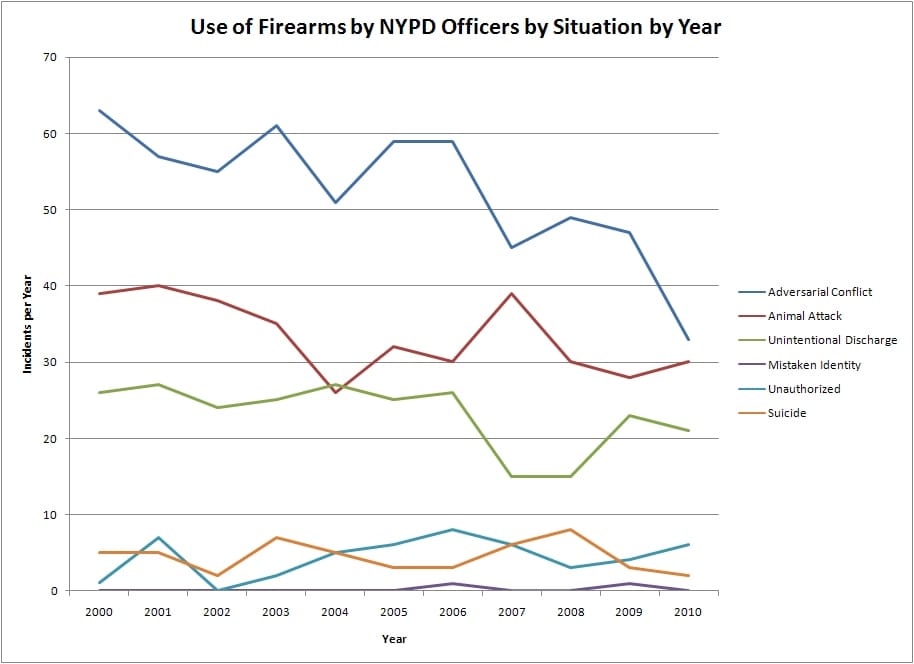RF sent me a link this morning to a report compiled for the New York City Police Department that outlined the circumstances behind every bullet fired by an NYPD cop that wasn’t on the firing range and was reported to their superiors. I popped their numbers into Excel and bashed in a quick line chart and the image above was my reward. But what does it MEAN?
The top line is “Adversarial Conflicts,” which is a nice way of saying the officers were being actively threatened by someone. 63% of the time these adversaries either had a firearm or the officers had a reasonable suspicion that one was about to be aimed in their direction, 24% of the time it was a knife, and the rest were blunt objects or threats.
This is the line we’re most interested in, as this downward trend indicates that officers have resorted to deadly force less often almost every year, dropping nearly 50% in a decade. But what is the driving force behind that drop?
The answer that comes to mind for me first is Taser usage. There have been a number of stories where the NYPD has been criticized for its wanton use of Tasers, and the availability of Tasers means that previously deadly situations are afforded an alternate ending than hot lead and cold bodies.
But the data doesn’t really bear that “more Tasers = less death” hypothesis out. If Tasers were being used to diffuse potentially lethal situations more often than in the past then incidents where rounds started flying in the officer’s direction would logically account for a much higher percentage of the total shootings than previous years — the assumption being that Tasers would be used more often for lower threats (like knives and blunt objects and threats of imminent death without actions) than bullets but the only response to hot lead is more hot lead. Going back as far as 1997 the proportion of flying lead related shootings to other situations has remained relatively unchanged throughout the years. That indicates that situations which warranted a lethal response in the past are still getting a lethal response.
The Second hypothesis is that officers are more reluctant to pull their triggers, and this is one I can’t comment on. The psychology of a police officer is something that I can’t tease out of a bar graph, and so you’ll have to draw your own conclusions about that one.
The third hypothesis for the decrease in cops pulling triggers on the street is a decrease in crime. If less people are committing crimes then fewer police are responding, and fewer responses means fewer chances for the police to get into a lethal situation. R=T*V*C, QED fewer run-ins means fewer shootings. AKA don’t be around stupid people doing stupid things.
The lower crime hypothesis is actually fairly plausible. The crime rate in New York City has been dropping fairly regularly over the last decade and is only a fraction of what it once was in the 1990’s. The driving force behind that drop in crime rate is another story for another day, but for now we’ll just say that it’s the one I favor the most to explain the fewer officer involved shootings.
In short, the NYPD are pulling their triggers fewer times each year. Whether the cause of that drop in ammo sales is due to the crime rate being on the decline or better training is anyone’s guess, but the numbers seem to indicate that fewer crimes means fewer shootings.
My take on these numbers? RF’s advice to avoid places where stupid people are doing stupid things is pretty damned solid.
Also of note: 34,565 “well trained” police officers have about 21 negligent discharges a year. And that number has been steady for quite some time.





“The crime rate in New York City has been dropping fairly regularly over the last decade and is only a fraction of what it once was in the 1990′s. The driving force behind that drop in crime rate is another story for another day…”
Safe and legal availability of abortion and elimination of lead in gasoline = less neglected, impulsive, brain damaged kids who become criminals.
Maybe the revolving door for repeat offenders is swinging ever so slightly slower?
But what does it MEAN?
It means that: bullets are expensive; politicians don’t like dead voters; when cops are prosecuted for breaking the law their fellow union members get the message; paying off the heirs is very expensive; the Mayor Against Guns would be embarrassed by another Amadou Diallo incident; and New York’s self-righteous Commissioner doesn’t need any heat while he’s trying to get his son off on rape charges.
It does not necessarily mean that crime is down, although the NYPD is vigorously cooking the books to make it seem so. It does mean that the NYPD has busied itself making more than 50,000 illegal arrests a year for non-criminal possession of marijuana in NYC, but hey, if we’re not going to let the NYPD shoot innocent people, then the least we can do is let them lock them up.
Comments are closed.